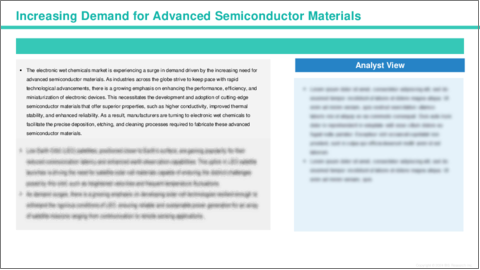|
|
市場調査レポート
商品コード
1501761
エレクトロニクス向けウェットケミカル市場 - 世界および地域の分析:用途・タイプ・地域別の分析・予測 (2024-2034年)Electronic Wet Chemicals Market - A Global and Regional Analysis: Focus on Application, Type, and Region - Analysis and Forecast, 2024-2034 |
||||||
カスタマイズ可能
|
|||||||
| エレクトロニクス向けウェットケミカル市場 - 世界および地域の分析:用途・タイプ・地域別の分析・予測 (2024-2034年) |
|
出版日: 2024年06月28日
発行: BIS Research
ページ情報: 英文 100 Pages
納期: 1~5営業日
|
全表示
- 概要
- 目次
世界のエレクトロニクス向けウェットケミカルの市場規模は、楽観的シナリオでは、2024年の43億2,000万米ドルから、CAGR 6.85%で推移し、2034年には83億9,000万米ドルに達すると予想されています。
| 主要市場統計 | |
|---|---|
| 予測期間 | 2024-2034年 |
| 2024年評価額 | 43億2,000万米ドル |
| 2034年予測 | 83億9,000万米ドル |
| CAGR | 6.85% |
エレクトロニクス産業の急速な拡大が、エレクトロニクス向けウェットケミカルの需要を牽引しています。これらの化学薬品は、洗浄、エッチング、表面治療、研磨など、電子機器製造のさまざまな段階で極めて重要です。業界の小型化、性能向上、コスト削減への絶え間ない取り組みが、エレクトロニクス向けウェットケミカルの採用増加につながっています。電子機器の高機能化・小型化に伴い、精密で信頼性の高いウェットケミカルソリューションの重要性が高まっています。このような需要の高まりは、最高品質の電子部品の生産を促進する上でエレクトロニクス向けウェットケミカルが果たす重要な役割を浮き彫りにし、市場の成長を促しています。
持続可能性と環境保全への注目が高まっていることも、エレクトロニクス向けウェットケミカル市場の主要な促進要因です。汚染や資源の枯渇に対する懸念が高まる中、メーカーは従来の化学プロセスに代わる環境に優しい代替品を求めています。エレクトロニクス向けウェットケミカルは、エレクトロニクス製造において高性能を維持しながら環境への影響を最小限に抑えるソリューションを提供します。このような持続可能性へのシフトは、エレクトロニクス分野におけるグリーンな実践を推進する政府の規制や業界のイニシアティブによって強化されています。
さらに、化学配合における継続的な技術の進歩と革新が、市場拡大の機会を後押ししています。BASF SE、Dow Chemical Company、Mitsubishi Chemical Corporationなどの企業は、業界の進化する需要に応える最先端のエレクトロニクス向けウェットケミカルを開発するリーダー企業です。R&Dへの投資の増加や、持続可能性へのコミットメントが、エレクトロニクス製造のサプライチェーン全体での、より環境に優しい化学ソリューションの採用を促進しています。
当レポートでは、世界のエレクトロニクス向けウェットケミカルの市場を調査し、業界の動向、技術・特許の動向、法規制環境、ケーススタディ、市場成長促進要因・抑制要因、市場規模の推移・予測、各種区分・地域/主要国別の詳細分析、競合情勢、主要企業のプロファイルなどをまとめています。
目次
エグゼクティブサマリー
第1章 市場:業界の展望
- 動向:現在および将来の影響評価
- 先端半導体材料の需要増加
- 環境に優しい処方への注目が高まる
- サプライチェーンの概要
- バリューチェーン分析
- 価格予測
- R&Dレビュー
- 特許出願動向:国・企業別
- 規制状況
- ステークホルダー分析
- 使用事例
- エンドユーザーと購入基準
- 主な世界的イベントの影響分析
- 市場力学の概要
- 市場促進要因
- 市場抑制要因
- 市場機会
第2章 エレクトロニクス向けウェットケミカル市場:用途別
- 用途の分類
- 用途の概要
- エレクトロニクス向けウェットケミカル市場:用途別
- 半導体
- プリント基板
- ICパッケージング
- その他
第3章 エレクトロニクス向けウェットケミカル市場:製品別
- 製品の分類
- 製品概要
- エレクトロニクス向けウェットケミカル市場:タイプ別
- 酢酸
- 水酸化アンモニウム
- 塩酸
- フッ化水素酸
- 過酸化水素
- イソプロピルアルコール
- 硝酸
- リン酸
- 硫酸
- その他
- エレクトロニクス向けウェットケミカル市場:形態別
- ガス
- 液体
- 固体
第4章 エレクトロニクス向けウェットケミカル市場:地域別
- エレクトロニクス向けウェットケミカル市場:地域別
- 北米
- 欧州
- アジア太平洋
- その他の地域
第5章 企業プロファイル
- 次なるフロンティア
- 地理的評価
- Air Products and Chemicals, Inc.
- BASF SE
- Cabot Microelectronics Corporation
- Dow Chemical Company
- Fujifilm Corporation
- Honeywell International Inc.
- KMG Chemicals, Inc.
- Linde plc
- Mitsubishi Chemical Corporation
- Sumitomo Chemical Co., Ltd.
- Technic Inc.
- Tokyo Ohka Kogyo Co., Ltd.
- Kanto Chemical Co. Inc.
- LANXESS
- Ineos
第6章 調査手法
Introduction to Electronic Wet Chemicals Market
The electronic wet chemicals market is undergoing significant growth, propelled by various key factors and market drivers. In an optimistic scenario, the market is evaluated at a valuation of $4.32 billion in 2024 and is projected to expand at a CAGR of 6.85% to reach $8.39 billion by 2034.
| KEY MARKET STATISTICS | |
|---|---|
| Forecast Period | 2024 - 2034 |
| 2024 Evaluation | $4.32 Billion |
| 2034 Forecast | $8.39 Billion |
| CAGR | 6.85% |
The electronics industry's rapid expansion is driving the demand for electronic wet chemicals. These chemicals are crucial in different stages of electronic manufacturing, including cleaning, etching, surface treatment, and polishing. The industry's constant drive for miniaturization, improved performance, and cost reduction is leading to increased adoption of electronic wet chemicals. With electronic devices becoming more sophisticated and compact, the importance of precise and reliable wet chemical solutions is growing. This rising demand highlights the critical role electronic wet chemicals play in facilitating the production of top-quality electronic components, thereby stimulating market growth.
The increasing focus on sustainability and environmental conservation is another key driver for the electronic wet chemicals market. With growing concerns about pollution and resource depletion, manufacturers are seeking eco-friendly alternatives to traditional chemical processes. Electronic wet chemicals offer solutions that minimize environmental impact while maintaining high performance in electronic manufacturing. This shift towards sustainability is reinforced by government regulations and industry initiatives promoting green practices in the electronics sector.
Moreover, ongoing technological advancements and innovations in chemical formulations are fueling opportunities for market expansion. Companies such as BASF SE, Dow Chemical Company, and Mitsubishi Chemical Corporation are among the leaders in developing cutting-edge electronic wet chemicals that meet the evolving demands of the industry. The growing investments in research and development, coupled with commitments to sustainability, are driving the adoption of greener chemical solutions across the electronics manufacturing supply chain.
Overall, the electronic wet chemicals market is experiencing steady growth, propelled by the increasing demand for advanced semiconductor materials and the continuous development of cutting-edge electronic devices. The shift towards smaller, more efficient electronic components has led to a greater need for high-performance wet chemicals used in semiconductor fabrication processes.
Market Segmentation:
Segmentation 1: by Application
- Semiconductor
- PCB
- IC Packaging
- Others
Segmentation 2: by Type
- Acetic Acid
- Ammonium Hydroxide
- Hydrochloric Acid
- Hydrofluoric Acid
- Hydrogen Peroxide
- Isopropyl Alcohol
- Nitric Acid
- Phosphoric Acid
- Sulfuric Acid
- Others
Segmentation 3: by Form
- Gas
- Liquid
- Solid
Segmentation 4: by Region
- North America
- Europe
- Asia-Pacific
- Rest-of-the-World
How can this report add value to an organization?
Product/Innovation Strategy: The global electronic wet chemicals market has been extensively segmented based on various categories, such as application, type, and form. This can help readers get a clear overview of which segments account for the largest share and which ones are well-positioned to grow in the coming years.
Competitive Strategy: A detailed competitive benchmarking of the players operating in the global electronic wet chemicals market has been done to help the reader understand how players stack against each other, presenting a clear market landscape. Additionally, comprehensive competitive strategies such as partnerships, agreements, and collaborations will aid the reader in understanding the untapped revenue pockets in the market.
Key Market Players and Competition Synopsis
The companies that are profiled have been selected based on thorough secondary research, which includes analyzing company coverage, product portfolio, market penetration, and insights gathered from primary experts.
Some of the prominent names in this market are:
- BASF SE
- Cabot Microelectronics Corporation
- Fujifilm Corporation
- Honeywell International Inc.
- Linde plc
- Technic Inc.
Key Questions Answered in this Report:
- What are the main factors driving the demand for electronic wet chemicals market?
- What are the major patents filed by the companies active in the electronic wet chemicals market?
- Who are the key players in the electronic wet chemicals market, and what are their respective market shares?
- What partnerships or collaborations are prominent among stakeholders in the electronic wet chemicals market?
- What are the strategies adopted by the key companies to gain a competitive edge in electronic wet chemicals market?
- What is the futuristic outlook for the electronic wet chemicals market in terms of growth potential?
- What is the current estimation of the electronic wet chemicals market and what growth trajectory is projected from 2024 to 2034?
- Which application, and product segment is expected to lead the market over the forecast period (2024-2034)?
- Which regions demonstrate the highest adoption rates for electronic wet chemicals market, and what factors contribute to their leadership?
Table of Contents
Executive Summary
Scope and Definition
Market/Product Definition
Key Questions Answered
Analysis and Forecast Note
1. Markets: Industry Outlook
- 1.1 Trends: Current and Future Impact Assessment
- 1.1.1 Increasing Demand for Advanced Semiconductor Materials
- 1.1.2 Growing Focus on Environmentally Friendly Formulations
- 1.2 Supply Chain Overview
- 1.2.1 Value Chain Analysis
- 1.2.2 Pricing Forecast
- 1.3 R&D Review
- 1.3.1 Patent Filing Trend by Country, by Company
- 1.4 Regulatory Landscape
- 1.5 Stakeholder Analysis
- 1.5.1 Use Case
- 1.5.2 End User and Buying Criteria
- 1.6 Impact Analysis for Key Global Events
- 1.7 Market Dynamics Overview
- 1.7.1 Market Drivers
- 1.7.2 Market Restraints
- 1.7.3 Market Opportunities
2. Electronic Wet Chemicals Market (by Application)
- 2.1 Application Segmentation
- 2.2 Application Summary
- 2.3 Electronic Wet Chemicals Market (by Application)
- 2.3.1 Semiconductor
- 2.3.2 PCB
- 2.3.3 IC Packaging
- 2.3.4 Others
3. Electronic Wet Chemicals Market (by Products)
- 3.1 Product Segmentation
- 3.2 Product Summary
- 3.3 Electronic Wet Chemicals Market (by Type)
- 3.3.1 Acetic Acid
- 3.3.2 Ammonium Hydroxide
- 3.3.3 Hydrochloric Acid
- 3.3.4 Hydrofluoric Acid
- 3.3.5 Hydrogen Peroxide
- 3.3.6 Isopropyl Alcohol
- 3.3.7 Nitric Acid
- 3.3.8 Phosphoric Acid
- 3.3.9 Sulfuric Acid
- 3.3.10 Others
- 3.4 Electronic Wet Chemicals Market (by Form)
- 3.4.1 Gas
- 3.4.2 Liquid
- 3.4.3 Solid
4. Electronic Wet Chemicals Market (by Region)
- 4.1 Electronic Wet Chemicals Market (by Region)
- 4.2 North America
- 4.2.1 Regional Overview
- 4.2.2 Driving Factors for Market Growth
- 4.2.3 Factors Challenging the Market
- 4.2.4 Application
- 4.2.5 Product
- 4.2.6 U.S.
- 4.2.6.1 Market by Application
- 4.2.6.2 Market by Product
- 4.2.7 Canada
- 4.2.7.1 Market by Application
- 4.2.7.2 Market by Product
- 4.2.8 Mexico
- 4.2.8.1 Market by Application
- 4.2.8.2 Market by Product
- 4.3 Europe
- 4.3.1 Regional Overview
- 4.3.2 Driving Factors for Market Growth
- 4.3.3 Factors Challenging the Market
- 4.3.4 Application
- 4.3.5 Product
- 4.3.6 Germany
- 4.3.6.1 Market by Application
- 4.3.6.2 Market by Product
- 4.3.7 France
- 4.3.7.1 Market by Application
- 4.3.7.2 Market by Product
- 4.3.8 U.K.
- 4.3.8.1 Market by Application
- 4.3.8.2 Market by Product
- 4.3.9 Italy
- 4.3.9.1 Market by Application
- 4.3.9.2 Market by Product
- 4.3.10 Rest-of-Europe
- 4.3.10.1 Market by Application
- 4.3.10.2 Market by Product
- 4.4 Asia-Pacific
- 4.4.1 Regional Overview
- 4.4.2 Driving Factors for Market Growth
- 4.4.3 Factors Challenging the Market
- 4.4.4 Application
- 4.4.5 Product
- 4.4.6 China
- 4.4.6.1 Market by Application
- 4.4.6.2 Market by Product
- 4.4.7 Japan
- 4.4.7.1 Market by Application
- 4.4.7.2 Market by Product
- 4.4.8 India
- 4.4.8.1 Market by Application
- 4.4.8.2 Market by Product
- 4.4.9 South Korea
- 4.4.9.1 Market by Application
- 4.4.9.2 Market by Product
- 4.4.10 Rest-of-Asia-Pacific
- 4.4.10.1 Market by Application
- 4.4.10.2 Market by Product
- 4.5 Rest-of-the-World
- 4.5.1 Regional Overview
- 4.5.2 Driving Factors for Market Growth
- 4.5.3 Factors Challenging the Market
- 4.5.4 Application
- 4.5.5 Product
- 4.5.6 South America
- 4.5.6.1 Market by Application
- 4.5.6.2 Market by Product
- 4.5.7 Middle East and Africa
- 4.5.7.1 Market by Application
- 4.5.7.2 Market by Product
5. Companies Profiled
- 5.1 Next Frontiers
- 5.2 Geographic Assessment
- 5.2.1 Air Products and Chemicals, Inc.
- 5.2.1.1 Overview
- 5.2.1.2 Top Products/Product Portfolio
- 5.2.1.3 Top Competitors
- 5.2.1.4 Target Customers
- 5.2.1.5 Key Personnel
- 5.2.1.6 Analyst View
- 5.2.1.7 Market Share
- 5.2.2 BASF SE
- 5.2.2.1 Overview
- 5.2.2.2 Top Products/Product Portfolio
- 5.2.2.3 Top Competitors
- 5.2.2.4 Target Customers
- 5.2.2.5 Key Personnel
- 5.2.2.6 Analyst View
- 5.2.2.7 Market Share
- 5.2.3 Cabot Microelectronics Corporation
- 5.2.3.1 Overview
- 5.2.3.2 Top Products/Product Portfolio
- 5.2.3.3 Top Competitors
- 5.2.3.4 Target Customers
- 5.2.3.5 Key Personnel
- 5.2.3.6 Analyst View
- 5.2.3.7 Market Share
- 5.2.4 Dow Chemical Company
- 5.2.4.1 Overview
- 5.2.4.2 Top Products/Product Portfolio
- 5.2.4.3 Top Competitors
- 5.2.4.4 Target Customers
- 5.2.4.5 Key Personnel
- 5.2.4.6 Analyst View
- 5.2.4.7 Market Share
- 5.2.5 Fujifilm Corporation
- 5.2.5.1 Overview
- 5.2.5.2 Top Products/Product Portfolio
- 5.2.5.3 Top Competitors
- 5.2.5.4 Target Customers
- 5.2.5.5 Key Personnel
- 5.2.5.6 Analyst View
- 5.2.5.7 Market Share
- 5.2.6 Honeywell International Inc.
- 5.2.6.1 Overview
- 5.2.6.2 Top Products/Product Portfolio
- 5.2.6.3 Top Competitors
- 5.2.6.4 Target Customers
- 5.2.6.5 Key Personnel
- 5.2.6.6 Analyst View
- 5.2.6.7 Market Share
- 5.2.7 KMG Chemicals, Inc.
- 5.2.7.1 Overview
- 5.2.7.2 Top Products/Product Portfolio
- 5.2.7.3 Top Competitors
- 5.2.7.4 Target Customers
- 5.2.7.5 Key Personnel
- 5.2.7.6 Analyst View
- 5.2.7.7 Market Share
- 5.2.8 Linde plc
- 5.2.8.1 Overview
- 5.2.8.2 Top Products/Product Portfolio
- 5.2.8.3 Top Competitors
- 5.2.8.4 Target Customers
- 5.2.8.5 Key Personnel
- 5.2.8.6 Analyst View
- 5.2.8.7 Market Share
- 5.2.9 Mitsubishi Chemical Corporation
- 5.2.9.1 Overview
- 5.2.9.2 Top Products/Product Portfolio
- 5.2.9.3 Top Competitors
- 5.2.9.4 Target Customers
- 5.2.9.5 Key Personnel
- 5.2.9.6 Analyst View
- 5.2.9.7 Market Share
- 5.2.10 Sumitomo Chemical Co., Ltd.
- 5.2.10.1 Overview
- 5.2.10.2 Top Products/Product Portfolio
- 5.2.10.3 Top Competitors
- 5.2.10.4 Target Customers
- 5.2.10.5 Key Personnel
- 5.2.10.6 Analyst View
- 5.2.10.7 Market Share
- 5.2.11 Technic Inc.
- 5.2.11.1 Overview
- 5.2.11.2 Top Products/Product Portfolio
- 5.2.11.3 Top Competitors
- 5.2.11.4 Target Customers
- 5.2.11.5 Key Personnel
- 5.2.11.6 Analyst View
- 5.2.11.7 Market Share
- 5.2.12 Tokyo Ohka Kogyo Co., Ltd.
- 5.2.12.1 Overview
- 5.2.12.2 Top Products/Product Portfolio
- 5.2.12.3 Top Competitors
- 5.2.12.4 Target Customers
- 5.2.12.5 Key Personnel
- 5.2.12.6 Analyst View
- 5.2.12.7 Market Share
- 5.2.13 Kanto Chemical Co. Inc.
- 5.2.13.1 Overview
- 5.2.13.2 Top Products/Product Portfolio
- 5.2.13.3 Top Competitors
- 5.2.13.4 Target Customers
- 5.2.13.5 Key Personnel
- 5.2.13.6 Analyst View
- 5.2.13.7 Market Share
- 5.2.14 LANXESS
- 5.2.14.1 Overview
- 5.2.14.2 Top Products/Product Portfolio
- 5.2.14.3 Top Competitors
- 5.2.14.4 Target Customers
- 5.2.14.5 Key Personnel
- 5.2.14.6 Analyst View
- 5.2.14.7 Market Share
- 5.2.15 Ineos
- 5.2.15.1 Overview
- 5.2.15.2 Top Products/Product Portfolio
- 5.2.15.3 Top Competitors
- 5.2.15.4 Target Customers
- 5.2.15.5 Key Personnel
- 5.2.15.6 Analyst View
- 5.2.15.7 Market Share
- 5.2.1 Air Products and Chemicals, Inc.





